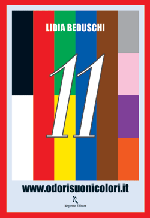Blue suits you: color as social and linguistic fact
Let us put this straight: even the congenitally blind have to deal with color since childhood. Since kindergarten age, scholastic integration brings vision-impaired child together with normally sighted children who love and use colors to draw, to describe the world and themselves, to make figures of speech and word games. Children live in a very colorful world.
Lest color become yet another mental and linguistic barrier hindering the communication with normally sighted schoolmates, children born blind must quickly familiarize with this huge unknown. Growing up, they will meet colors by reading books, learning to choose clothes, using such metaphors as "I'm red with shame", or "green with jealousy".
A special device called "color test" can be found at typhlotechnic centers: it has a small camera and a synthetic voice. When put before a piece of cloth or other colored surface, the device will vocalize the name of the color. This allows children, for instance, to know the color of the shirt to wear in the morning. This kind of device, in spite of its huge practical value, does not (nor tries to) affect the relationship of the congenitally blind with colors. To mechanically recognize the hue of a cloth, to know that the setting sun is red, to tell by heart the whole spectrum of primary colors, can become an exercise in futility, yet another task the vision-impaired person will have to shoulder, in order to adapt to a largely obscure and unknown reality.
Indeed, while to the normally sighted the world is a friendly mix of reassuring known and challenging unknown, the vision-impaired must navigate through a boundary of murky, hazy indistinctness before they can interact with even the most familiar objects.
Color instead can and must be slowly assimilated by vision-impaired persons, to become part of their daily life. Even a glance at an ID card reveals chromatic data, such as eye and hair color, needed to qualify a person as opposed to others. Bearing these data in mind, the person must learn to choose clothes and accessories that best match their physical traits. The statistical occurrence of judgments expressed by the normally sighted can be a useful tool in this respect, acting as part of a process of learning by imitation. I have always been told: "blue suits you", and I always felt a need to attach a psychological, rather than descriptive, meaning to this statement. Undoubtedly, our identity is partly shaped through recognition and trend, but it also is, even in its most outward traits, a thoroughly personal experience.
This is why blue is much more than an abstraction to me: when I wear blue, I feel I exude a sense of well-being and harmony. This would not be the case if I wore, for instance, yellow.
It could be argued that to speak of colors without having experienced them makes for unwarranted use of language. Still, words do not just have the function of communicating and describing reality. Words remove, for instance, the need to repeat a direct experience of objects, as when speaking of events that are long past and not repeatable, or too far removed in space to be directly experienced. Many speak about America without ever having been there, or about medieval knights without ever having met one. Language tells even those things that we will never be able to verify, but science admits as hypotheses, such as the Big Bang. According to philosopher Wittgenstein, blind persons can easily talk about what they cannot see, without being charged with delusion, superstition or dreaming. Wittgenstein writes: "A blind man can say that he is blind, while people around him can see. 'Yes, but then won't he, by the words "blind" and "seeing", mean something else than what the normally sighted mean?' Now, what is the ground for asking such a question? Well, even ignoring how a leopard looks, one could say and understand 'This place is dangerous, here be leopards'." (Pp.129-130)
Language, therefore, allows us all, blind and normally sighted, to know what we cannot touch, and becomes an extraordinary and surprising substitute for the actual experience, far from being abstract and meaningless. Vision remains the priority channel for color perception, but color, far from being banned from the world of the visually impaired, can also take new value from the way the blind speak about it, all without losing the basic connotations shared by the normally sighted.


